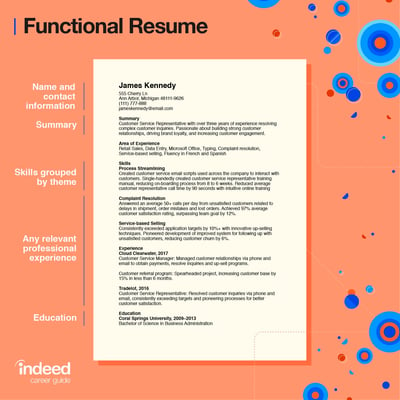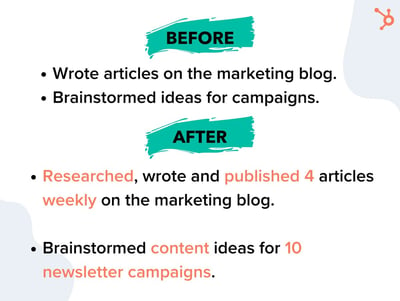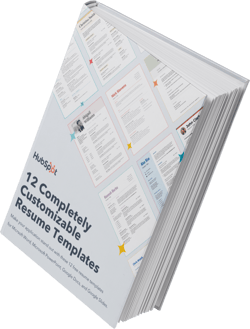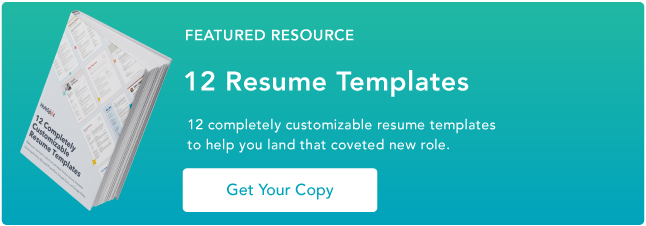Resume Tips to Get You The Job You Want, Straight from Recruiters
I can’t think of many tasks people dread more than writing a resume. There are so many little things you need to add, rephrase, check, double-check, triple-check.
Post-pandemic, the job search is a whole different ball game, with new considerations you haven’t faced before.
A checklist makes everything seem less daunting so that’s what much of this article will be, and the best part is it’s recruiter-approved. Let’s dive in.
1. Include your contact information.
This seems like a given, right? Not exactly.
“You would be surprised to know how many really good resumes I’ve come across with no contact information,” says Ira Hughley, senior technical recruiter at HubSpot.
Make sure your full name, email address, and location are included. Don’t write out your full home address though, only a city and state.
While your location may not be too relevant to the job itself, as more roles are remote than ever before, employers still want to know your general location for tax and law purposes.
This also means that you should probably remove references that are too local, as your resume will likely reach a broader audience than before.
Lastly, make sure your email address is professional. While the time of MSN and AIM usernames are long gone, many of us still use old addresses we created long before we were in the workforce.
With this in mind, create a simple email with your first and last name. If it’s already taken, consider adding your industry to your email. E.g.: martinabretous.writing@gmail.com
2. Tailor your resume to the role.
One of the biggest mistakes job seekers make is using the same resume for every role they apply for.
Hughley recommends having multiple resume versions for each role category you’re interested in.
“Don’t try to cram all of your experience into the resume,” he says. “Sometimes you can talk to them during the interview.”
The same goes for keeping old roles that are no longer relevant.
“Be 110% sure that your work experience and interests match the job opportunity you are looking to get,” says Hughley. “Too often, I see resumes with tons of experience in areas other than the one being applied for.”
Instead, note roles that highlight your experience and show why you are a good fit for the role.
“What if I’m transitioning to a new industry and don’t have much experience, what should I do?” In this case, build a functional resume that frames your past experience to match the job you’re seeking.
For instance, say you’re transitioning to a developer role but only have experience in writing. Well, developer roles require problem-solving, critical thinking, time management, and a willingness to learn.
In this case, you can highlight the same skills in your writing role, like:
- Meeting deadlines – time management
- Brainstorming new article ideas – critical thinking
- Analyzing article performance and suggesting optimization strategies – problem-solving
While you may not have the experience, you probably have transferable skills that will help you excel in your new role.
3. Describe your experience in detail.
When it comes to the experience section, there are the basics we all know to input: Previous companies, job titles, and responsibilities. There are two additional details you shouldn’t forget to add: The results you achieved and the awards you received.
One issue Hughley often sees with resumes is that they’re too vague.
“Highlight yourself! Sometimes, I see just a title and no highlights or takeaways from that role,” he says. “This is the time to brag about what you have accomplished, even if it’s just a couple of bullet points.”
HubSpot Recruiter Timothy Dixon-Traylor says we often leave out important details that could help us stand out.
“I believe the most important part of the resume is to show how you’ve made an impact in your current and previous roles,” he said. “This can be done by quantifying your results and impacts, as best you can.”
Dixon-Traylor continues, “Most recruiters and hiring managers will be asking themselves, ‘How can this person help elevate the team and the organization?’Quantifying your contributions will be your first step showcasing how,” he said.

Did your work lead to higher revenue, conversions, traffic, etc? Make sure to mention that and add figures.
Next, use action verbs. Instead of “worked on,” write “led,” “managed,” “brainstormed.” This adds specificity to your responsibilities and helps employers better understand your previous roles.
“Avoid short phrases such as “assist customers” or “make cold calls to prospects,” Dixon-Traylor says. “What are you assisting these customers to do? How many customers are you working with a day? Do you have any KPIs or metrics that align with those activities? It goes back to my previous point of quantifying your impact to show how valuable you are.”
Another thing to avoid? Fluff.
Dixon-Traylor suggests asking yourself if your content is showcasing your abilities and the value you bring. If not, go back to the drawing board.
4. Summarize your experience in a “Key Skills” section.
Your skills section is one of the most important in your resume. Hiring managers and automated resume scanners look at this section to assess if you have the relevant skills.
As such, do not put your skills section all the way at the bottom. Instead, put it toward the top of the resume above your experience section or to the side. Ideally, the hiring manager gets a sense of your skills and your experience shows how you gained them.
5. Design your resume using a template that fits the tone of your industry.
Every industry has an unofficial way of doing things when it comes to hiring.
For instance, traditionally creative industries tend to allow (and in some cases promote) showing some personality in resumes. This can range from adding your picture to your resume to using bright colors and illustrations.
Be sure to follow the tone that’s most appropriate for your industry – no need to reinvent the wheel when the guide is already there.
In addition, Dixton-Traylor suggests using a good balance of white space without crowding the page.
“Use as much white space as possible, on one to two pages that showcase the value you bring,” he says. “Add the technologies, skills, systems, or programs that you have hands-on experience working with. This can range from technical tools, such as Tableau and HubSpot down to simple tools like POS systems, Microsoft Office, or Google Suite.”
Want more design tips? Jump to this section.
6. Incorporate keywords from the job description.
There are two reasons you want your resume to have the keywords from the job description:
- It will show hiring managers that your skills and experience closely align with the job req.
- You will ensure that your resume successfully passes through automated resume scanners, which look for keyword matches.
7. Proofread for grammar, brevity, and specific action verbs.
One thing you don’t want is an error in your resume. It can affect your credibility and make you look unprofessional.
So, the first step is proofreading your resume. Once you complete it, leave it for a few hours or days then give it another look.
Then, run it through grammar editing software to make sure everything is correct. Here are some good options:
8. Convert your resume to a PDF file.
Imagine you spend hours formatting your resume just for it all to get lost once someone else opens it. That’s what happens when you submit your resume using Word.
Instead, convert your final resume into a PDF file to preserve your formatting. This also ensures easy uploading on most hiring forms.
How The Pandemic Impacted The Hiring Process
When COVID-19 surfaced in early March of 2020, it created a lot of uncertainty in the market. Unemployment rates skyrocketed to 14.7%, as companies struggled with
Now, two years later, the outlook is more positive.
“The talent pool has drastically expanded because most companies are remote, which means that talent is no longer limited by location,” Hughley says.
This is great news for job seekers who were once constrained to the job opportunities in their local areas. A job market that was favorable to companies has now switched to being favorable to job seekers.
Employers have to offer better benefits with more flexibility to be competitive, everything from remote stipends to unlimited vacation days.
“There is a shift now as well because many recruitment platforms have moved to online or virtual strategy,” Hughley adds. “We have to find more creative ways to connect to candidates to make for the best candidate experience.
Lastly, Hughley says that the pandemic has made hiring managers more empathetic toward candidates.
“When I think of […] all that applicants have had to endure, I make a conscious effort to lead all hiring and conversations with empathy,” he says.
Dixon-Traylor adds the pandemic has brought more humanity into the hiring process.
“Pre-pandemic, I loved advocating for candidates who don’t have ‘ideal’ backgrounds – from job hoppers and folks who have gaps to folks who don’t have direct experience, but have impeccable transferable skills,” he said. “Since the pandemic, I advocate even more those communities, in the entire hiring process.”
He continues to say that he looks at hiring as a long-term strategy, guiding hiring managers through their unconscious biases and helping them understand minimum requirements versus what can be coached or taught.
The Ultimate Checklist of Resume Tips
Contact Information Tips
- Include your basic contact information – including your name, email address, and phone number – at the top?
- Is your email address professional? (e.g. sara@gmail.com vs. saracutiebear@gmail.com)
- Is your email address associated with a familiar domain, like Gmail? Outdated domains can be a red flag for tech-savvy companies.
- Do your resume details align with your LinkedIn profile? Hiring managers will likely review both.
- Have you included links to social media profiles, portfolios, and a personal website if relevant?
- Have you audited your social profiles to ensure no unprofessional content is available to the public?
- Have you customized any communication within your resume that addresses the company or hiring manager by name?
- Have you granted the recipient the proper permissions to view it (or opened up permissions to everyone)? If you’re sending your resume as a Google Doc.
Featured Resource: 12 Free Resume Templates

Download 12 free designed, formatted, and customizable resume templates here.
Writing for Your Industry Tips
- Are you writing in a tone that matches that of the company to which you’re applying? For instance, while still writing professionally, you might use a different tone when applying to work at a new tech startup versus an established accounting firm.
- Have you customized your resume for the specific job to which you’re applying? Highlight work experience and skills that are relevant to the position – don’t just write down every job you’ve ever held.
- Do you have a clear objective at the top of your resume that is company-focused, rather than you-focused? You don’t need one, but you do need a “Key Skills” section that summarizes who you are and what you can offer the company.
- Have you included both accomplishments and responsibilities under each job? Both should be easy to ascertain when scanning your resume.
- Have you used numbers and metrics where possible to better convey your success? For example: “Generated 150 marketing-qualified leads,” “Increased Instagram followers by 25%,” “Oversaw a $250K budget.”
- Do you illustrate career progression? It should be clear if you were promoted, gained additional responsibility, or switched jobs laterally to acquire more skills.
- What company details have you added? List not only the names of companies but a short description of what each company does.
- Have you included your tenure at each company?
- Have you included relevant information about your education?
- Does your unique value proposition shine through? E.g., something that makes you stand out from other applicants, or highlights that you’re uniquely qualified for the position.
- If relevant for the position, have you included links to a portfolio or samples of your work?
Formatting and Design Tips
- Have you used a resume template so the layout of your resume is visually appealing and easy to read? Get 10 free templates here.
- Is your resume too creative? (For instance, if you’re applying for a creative position and have formatted your resume as an infographic … is it really simple enough to read, or is it best to save that creativity for your portfolio?
- Have you selected a clear, easy-to-read font? Is your name clearly stated at the top? It’s a good idea to make your name slightly larger than all other text – employers read many resumes every week, and you need to be memorable.
- Have you made use of common formatting conventions that make content easier to read, such as bullet points and header text?
- Has your formatting remained consistent across all positions? For example, if you’ve bolded job titles, are all job titles indeed bolded?
- Are your margins even?
- Are all items properly aligned? For example, if you’ve right-aligned dates, are they all lining up in tandem with one another?
- Are all links you’ve included clickable?
- Have you converted your resume to a format that allows all recipients to read it as intended, without downloading specific fonts or needing special software? A PDF format is recommended.
Editing Tips
- Have you included keywords in your resume? If you’re submitting to an automated system, it might be critical to get past filters. Be sure your resume directly reflects some of the software and skills mentioned in the job description.
- Have you edited it for brevity? Try to keep your resume to about one page per 10 years of job experience, if possible.
- Have you removed irrelevant job experiences?
- Is each section of your resume ranked in a way that highlights your skills and what you have to offer the employer? For instance, if you’re a recent graduate with internships in different fields, you might list your most relevant experience at the top, instead of ordering everything by date.
- Have you edited out generic action verbs in favor of more specific ones? For instance, “managed” instead of simply “worked.”
- Have you made use of a thesaurus to prevent monotony?
- Have you found more professional alternatives to unprofessional-sounding terms? “Tasked with,” for example, can make you seem less proactive than someone who “coordinated” various projects regardless of who told them to.
- Are your special skills truly special? While speaking a foreign language is indeed noteworthy, these days, it might be redundant to mention that you’re proficient in Microsoft Word or capable of using email.
- Have you done a sweep for annoying jargon or business babble? Everything should be clearly articulated, so it’s easy for the hiring manager to quickly understand what you do.
- Is everything 100% true? If you write that you’re fluent in a foreign language on your resume, you should be prepared to speak that language during your interview.
- Have you conducted spelling grammar checks?
- Finally, have you asked a friend who hasn’t read your resume before to provide a final glance for errors, inconsistencies, or confusing phrasing?
If you’ve checked the boxes of all the resume tips that apply to you, you should be ready to submit your application.
Editor’s Note: This post was originally published in March 2018 and has been updated for comprehensiveness.
![]()


![→ Download Now: 12 Resume Templates [Free Download]](https://no-cache.hubspot.com/cta/default/53/4ec95757-585e-40cf-9189-6b3885074e98.png)
